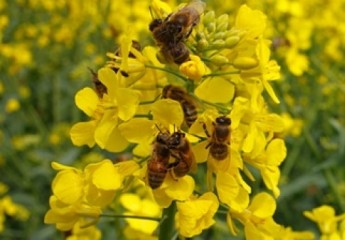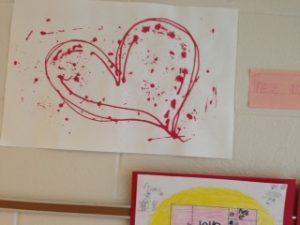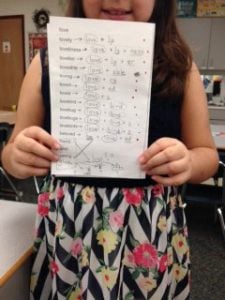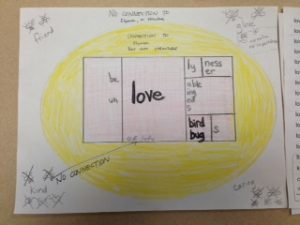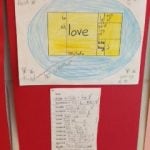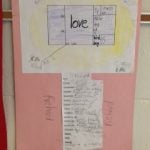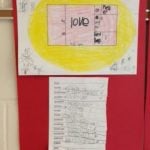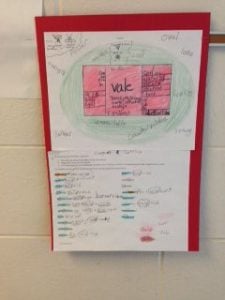These past few days my groups have been learning about the structures of words that we use often in the middle of February….. love and Valentine. We learned the origins of each of these words. <love> comes from Old English and is a free base (can be a word on its own without any affixes). We learned that <valentine> comes from Latin and has a bound base of <vale> (a bound base is an element that must have an affix attached to surface as a word in English). Bound bases are very useful and can be hidden in many other words but only those that share the etymon (the denotation of the root word) are related.
We finished analyzing words to see which elements each was made from, looking for connections of meaning and structure along the way. Some of the words we analyzed:
loving –> love + ing (spelling convention: replace single, silent, final <e>)
loved –> love + ed
lovely–> love + ly
loveliness–> love + ly + ness (spelling convention change y to i)
lovebugs –> love + bug + s (compound word: no spelling convention)
lovable –> love + able (hmm…2 acceptable ways to spell this one!)
unloved –> un + love + ed (prefix: no spelling convention; suffix — yes)
beloved –> be + love + ed (hint — we’ll talk about this one later)
Along with these wonderfully, lovely word sums, we also discussed the parts of speech each of these words can be — may depend on how it is used in context — grammar, grammar, everywhere!
He loves pizza. (verb)
Oh, pizza and steak, my two favorite loves! (noun)
The girl has a beloved dog. (adj.)
That dog is her beloved. (noun)
We also learned that some words have more than one way to pronounce them, like ‘beloved’ which can be /bəlʌvd/ or /bəlʌvɪd/ — the suffix <-ed> has an allophone — more than one way to pronounce this grapheme. We analyzed and organized our list of affixes into a matrix. We made a rough draft before making a final copy to display in the hallway.
One of the last things this lovely group of 3rd graders did, was to learn about other words that may or may not have a direct relationship with <love>. We did not find any relatives that share the same etymon even with a different spelling so we did not have any words to place in the oval (words that share etymon AND structure, spelling of the base, go in the matrix; words that share an etymon but not the same spelling of the base go in the oval).
We did have a few words that are often synonymous with ‘love’ or used to show our love for our friends such as: caring, kind, and friend. We placed those words outside of the oval on our white papers.
We found a word that shares the same letters and sounds as our word, it was <glove>. But, we quickly determined that their was no meaningful relationship to <love>. In this 30 second video, you’ll see the kids practicing this learning…..it takes a lot of thinking to see letters with our eyes and hear phonemes with our ears and STILL understand that they are in no way related. There are only 26 letters in the alphabet, you know, so there are bound to be repeated letters and sounds but without a meaningful connection, those are just random things to remember. We have proven, through the progress and confidence the students are gaining with studying the structures and meanings of words, that the letters and sounds just are not as important to our learning as the meaning and structure connections.
The fifth grade group tackled the bound base element <vale> which denotes strength, worth, power, health” and is part of the word ‘valentine’ –we were surprised to learn it did not mean love but we can see how its denotations are meaningful. When we give a valentine to our friends or loved ones, we are showing them the strength of our affection or friendship with them.
Some of the words we were surprised to find connected with this base element whose origin is the same Latin etymon of valere, are ‘convalescent’ and ‘convalesce’.
con + vale/ + esce/ + ent –> convalescent
con + vale/ + esce –> convalesce
What most of us thought of as ‘an old folks home’ is actually a place to live while one regains strength and health. Clearly, this is a related word and provides a much deeper connection to both valentine and these two words. We also learned that the pronunciation shifts on the suffix <-esce> from a short /e/ to a long /e/ (IPA /ɛ/ to /i:/).
Studying bound bases of Latin origin often generates much longer lists of related words, both inside the matrix as well as inside the oval, so this group needs a bit more time to complete their work. They are working in pairs or trios and have had many days with one or both partners is absent (we may need to study viruses next!), however, one group was lucky enough to have less interruptions and has displayed their work.
Our first graders were in on the action too — creating a valuable [vale/ + u + able –> ] resource for their learning as well!
We hope you have a lovely Valentine‘s Day with your loved ones and we hope your love is [equ + i + vale + ent –>] equivalent to that of an ocean!
